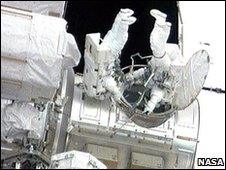Atlantis astronauts complete walk
- Published

Garrett Reisman and Steve Bowen emerge from the airlock
Astronauts on the shuttle Atlantis's latest, and probably, last mission to the space station have made their first spacewalk.
Mission specialists Garrett Reisman and Steve Bowen ventured outside the platform to install an antenna and a robot tool tray.
Atlantis arrived at the station on Sunday following a picture perfect launch from Florida on Friday.
The ship's crew of six are spending the next week at the 350km-high outpost.
Other key tasks will include the replacement of six large batteries and the addition to the underside of the platform of a Russian docking and storage module.
The berthing on Tuesday of the Rassvet module to the Earth-facing port of the station's Zarya unit is likely to be the trickiest operation of the entire mission.
Cable niggle
The Atlantis crew were unable to do their usual full post-launch inspection of the orbiter's external surfaces on Saturday due to a snagged cable that prevented the ship's robotic arm from picking up a high-resolution laser imager and TV camera.
To compensate for some of the missing data, mission managers instead ordered more pictures than usual to be taken from the space station of the shuttle as it moved in for its docking.
Three station crew-members took a total of 398 photographs of Atlantis's heat-shield as the orbiter performed a back-flip. The pictures were then sent down to Earth for analysis.
The docking occurred at 1428 GMT, with the hatch opening and the movement of the Atlantis crew through into the International Space Station (ISS) taking place a little under two hours later.
"It's bigger than we remember and, speaking for myself, better than I remember," shuttle commander Ken "Hock" Ham was heard to say on the radio. "I love this place."
Atlantis is undertaking what many expect to be its last mission before retirement.
'Standby' role
US President Barack Obama has announced a new exploration policy that he says would take humans beyond the International Space Station (ISS), beyond even the Moon, to asteroids and to Mars.
The shuttles, which have been working in space since 1981, cannot fulfil that role.
Nasa is being asked to pass the business of taxiing astronauts to and from the ISS to private companies and to concentrate its efforts on developing the vehicles that can reach more distant targets.
After it returns from the station, Atlantis will not go straight to a museum. It will instead be prepared as a standby vessel ready to go to the rescue of the astronauts on November's flight of the Endeavour orbiter should they get into trouble.
Nasa has not excluded the possibility that it could yet fly out the standby Atlantis to take additional spares and supplies to the space station.
The next shuttle mission - what should be the second to last - will see Discovery deliver a container full of supplies and spares to the ISS. Nasa is working towards a September lift-off.